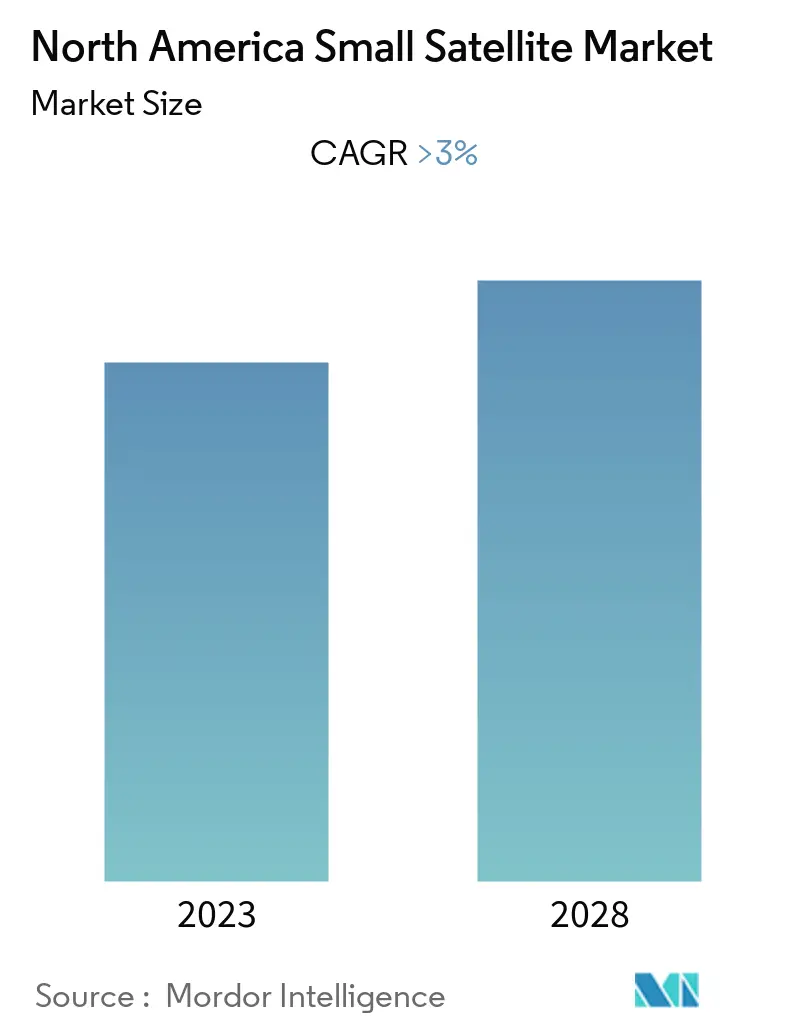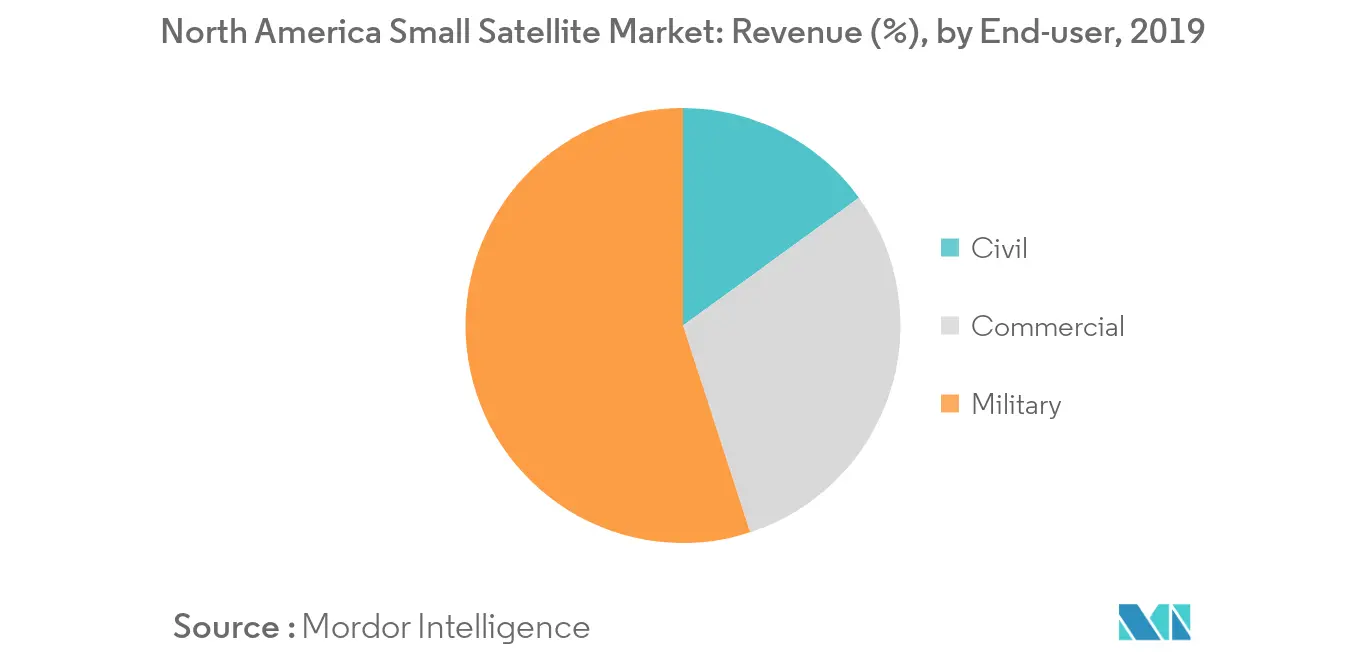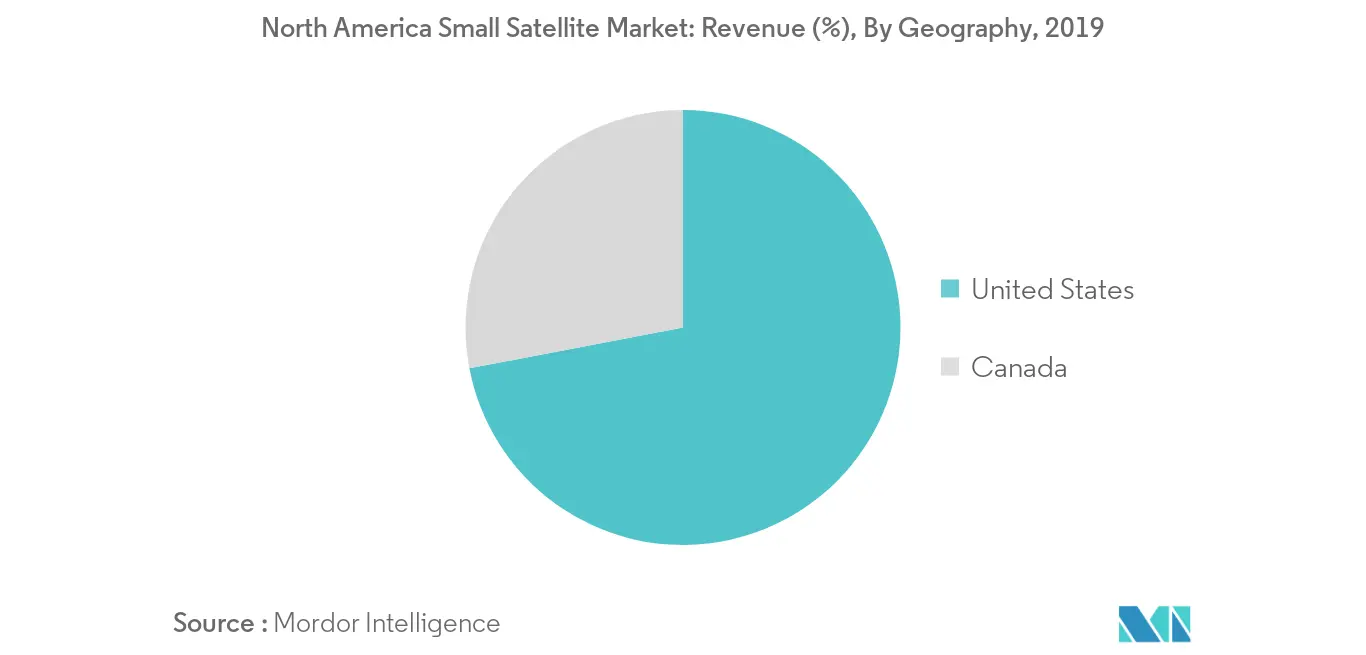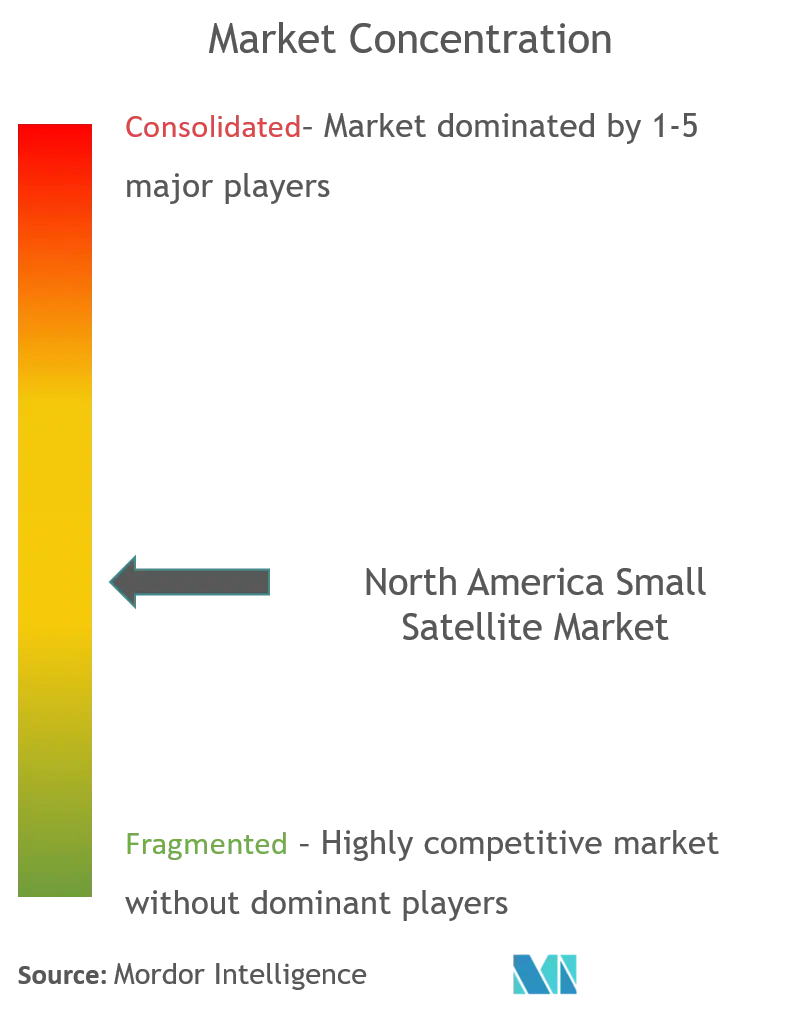North America Small Satellite Market Size

| Study Period | 2018 - 2028 |
| Base Year For Estimation | 2021 |
| Forecast Data Period | 2024 - 2028 |
| Historical Data Period | 2018 - 2020 |
| CAGR | > 3.00 % |
Major Players
*Disclaimer: Major Players sorted in no particular order |
Need a report that reflects how COVID-19 has impacted this market and its growth?
North America Small Satellite Market Analysis
The North American small satellite market is anticipated to register a CAGR of over 3% during the forecast period.
- With the advent of technology, the nature of battles has changed drastically. For various military requirements, including communication, defense agencies around the world require space capability to meet the demand for more operationally responsive forces. Nano and microsatellites can provide high visibility against tactical enemy operations. Rapid access to near-real-time information and imagery can be helpful for the aerial reconnaissance augmentation process. The nano and microsatellites can also be readily deployed in times of crisis to fill the missing gap for military operations.
- The demand for satellite networks and services for commercial applications has increased. The entry of companies, such as Google and Facebook, with commercial services demanding satellite bandwidth and networks, has also aided the market. To meet the growing demand for commercial applications, hundreds of new satellites need to be launched. Also, the regulatory relaxation on the sale of high-resolution satellite images for commercial purposes is one of such measures that has provided a new opportunity for the growth of the market.
- However, in the recent wake of COVID-19, the current outlook for the satellite industry in North America remains uncertain at this point as the outbreak has caused unforeseen disruptions in the region for both satellite manufacturers and launch service providers.
North America Small Satellite Market Trends
This section covers the major market trends shaping the North America Small Satellite Market according to our research experts:
Military Segment to Register the Highest CAGR During the Forecast Period
Military satellites are used for two specific mission profiles - surveillance and reconnaissance. Military satellites are capable of providing continuous coverage of an area and can be used for early warning in case the launch of an intercontinental ballistic missile is detected. The sensors mounted on these satellites can also automatically sense nuclear explosions and determine the location of the detonation, while further conveying the essential information required for a strategic strike assessment. Previously, technologically advanced countries were pioneers in developing military satellites but with the advent of smart sensors and miniature satellites, many nations around the world have either developed their military satellite network or collaborates with their technology partners to access the technology as per their requirement. Several development projects are underway, and they may result in the creation of potential market opportunities for global players during the forecast period. For instance, the US Defense Advanced Research Projects Agency (DARPA) is developing a prototype line of cost-effective reconnaissance satellites, as part of a program called "Blackjack". The program aims to integrate reconnaissance and communications payloads into standard commercial satellites, owing to their higher launch rate to accelerate the pace of formation of a constellation. The success of the program will influence the US' space program, which aims to set up a low Earth orbit (LEO) constellation of around 90 satellites by 2022. On a similar note, in November 2018, Dynetics Inc. (Dynetics) was selected for conducting hardware-in-the-loop testing and simulation for the US Army Space and Missile Defense Command/Army Forces Strategic Command (USASMDC/ARSTRAT) Technical Center Program named Gunsmoke-L. As of May 2020, DARPA had plans to launch the first experimental satellites of the Blackjack program in late 2020 and early 2021. Such developments are envisioned to drive the growth of the military segment of the North American small satellite market during the forecast period.

The United States to Dominate the Market in the Upcoming Period
The small satellite industry in the US is bolstered by the presence of a robust framework for designing and manufacturing small satellites that are custom designed to serve specific application profiles. Thus, several small satellites are launched by the US-based operators each year for satiating the demand for such satellites for a plethora of applications. For instance, besides earth observation and communication, several small satellite programs are aimed toward normal matter surveying of galaxies, planets, and stars. On this note, in July 2018, NASA launched the HaloSat to map the distribution of hot gas in the Milky Way galaxy. The HaloSat is built by Blue Canyon Technologies Inc., and it is based on the XB1 bus and the L3 Cadet radio. The payload consists of three XR-100SDD silicon drift detectors (SDDs), X-ray collimator, anti-coincidence shield, and associated electronics. The diversified application portfolio is expected to create additional demand for small satellites in the United States during the forecast period, in order to replace the conventional full-scale satellites as small satellites offer better performance to cost ratio.

North America Small Satellite Industry Overview
Though the North American small satellite market is characterized by the presence of several players, the market is dominated by only a few players, owing to their huge product portfolios. Since traditional satellite manufacturers are not the sole investors in the market, a radical change in the market dynamics is anticipated to emerge. Hence, to retain their competitive edge, some satellite ventures plan to manufacture space systems, payloads, or subsystems and components inhouse. For instance, in April 2019, OneWeb Satellites, a JV startup formed with the technological support from Airbus, announced its plans to build most of its 900 satellites inhouse at a new facility in Florida, US. Also, major technological shifts, such as miniaturization, and the advent of reusable satellite launch vehicle systems may necessitate the subsequent adaptation for seizing emerging market opportunities. Moreover, owing to the long R&D period associated with the satellite industry, some companies are exposed to certain risks associated with design responsibility, the development of new production tools, more capital and funding commitments, delivery schedules, and unique contractual requirements. These risks, if not resolved swiftly, can affect the financial status of the market players and expose them to revenue fluctuations.
North America Small Satellite Market Leaders
Northrop Grumman Corporation
Millennium Space Systems, Inc. (The Boeing Company)
Thales Alenia Space
Planet Labs, Inc.
Adcole Maryland Aerospace, LLC
*Disclaimer: Major Players sorted in no particular order

North America Small Satellite Market Report - Table of Contents
-
1. INTRODUCTION
-
1.1 Study Assumptions
-
1.2 Scope of the Study
-
-
2. RESEARCH METHODOLOGY
-
3. EXECUTIVE SUMMARY
-
4. MARKET DYNAMICS
-
4.1 Market Overview
-
4.2 Market Drivers
-
4.3 Market Restraints
-
4.4 Porter's Five Forces Analysis
-
4.4.1 Bargaining Power of Buyers/Consumers
-
4.4.2 Bargaining Power of Suppliers
-
4.4.3 Threat of New Entrants
-
4.4.4 Threat of Substitute Products
-
4.4.5 Intensity of Competitive Rivalry
-
-
-
5. MARKET SEGMENTATION
-
5.1 Application
-
5.1.1 Communication
-
5.1.2 Military Surveillance
-
5.1.3 Earth Observation
-
5.1.4 Other Applications
-
-
5.2 End-user
-
5.2.1 Civil
-
5.2.2 Commercial
-
5.2.3 Military
-
-
5.3 Geography
-
5.3.1 United States
-
5.3.2 Canada
-
-
-
6. COMPETITIVE LANDSCAPE
-
6.1 Company Profiles
-
6.1.1 Adcole Maryland Aerospace LLC
-
6.1.2 Blue Canyon Technologies Inc.
-
6.1.3 L3Harris Technologies Inc.
-
6.1.4 Millennium Space Systems Inc. (The Boeing Company)
-
6.1.5 Northrop Grumman Corporation
-
6.1.6 Planet Labs Inc.
-
6.1.7 Sierra Nevada Corporation
-
6.1.8 Spire Global Inc.
-
6.1.9 Surrey Satellite Technology Ltd (Airbus SE)
-
6.1.10 Thales Alenia Space
-
-
-
7. MARKET OPPORTUNITIES AND FUTURE TRENDS
North America Small Satellite Industry Segmentation
Small satellites, with a weight profile of less than 500 kg, are being used for collecting data on agriculture, mineral prospecting, urban development, border and maritime security, forestry, ocean resources, and disaster management, like drought and flood forecasting. This has driven governments across the world to adopt satellite services, thus, propelling the demand for satellites and initiating numerous launches for both commercial and military purposes. The report excludes R&D costs associated with satellites and the associated set up and operational costs of ground-based monitoring systems. The resupply missions for various space agencies are also excluded from the scope of the study. Moreover, state-owned space organizations, such as the US' National Aeronautics and Space Administration (NASA), have been excluded from the list of market players.
| Application | |
| Communication | |
| Military Surveillance | |
| Earth Observation | |
| Other Applications |
| End-user | |
| Civil | |
| Commercial | |
| Military |
| Geography | |
| United States | |
| Canada |
North America Small Satellite Market Research FAQs
What is the current North America Small Satellite Market size?
The North America Small Satellite Market is projected to register a CAGR of greater than 3% during the forecast period (2023-2028).
Who are the key players in North America Small Satellite Market?
Northrop Grumman Corporation, Millennium Space Systems, Inc. (The Boeing Company), Thales Alenia Space, Planet Labs, Inc. and Adcole Maryland Aerospace, LLC are the major companies operating in the North America Small Satellite Market.
North America Small Satellite Industry Report
Statistics for the 2023 North America Small Satellite market share, size and revenue growth rate, created by Mordor Intelligence™ Industry Reports. North America Small Satellite analysis includes a market forecast outlook to 2028 and historical overview. Get a sample of this industry analysis as a free report PDF download.
